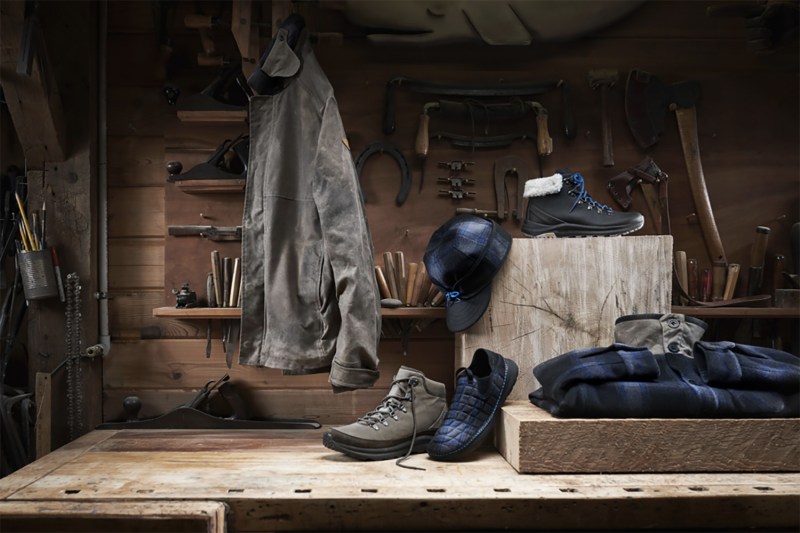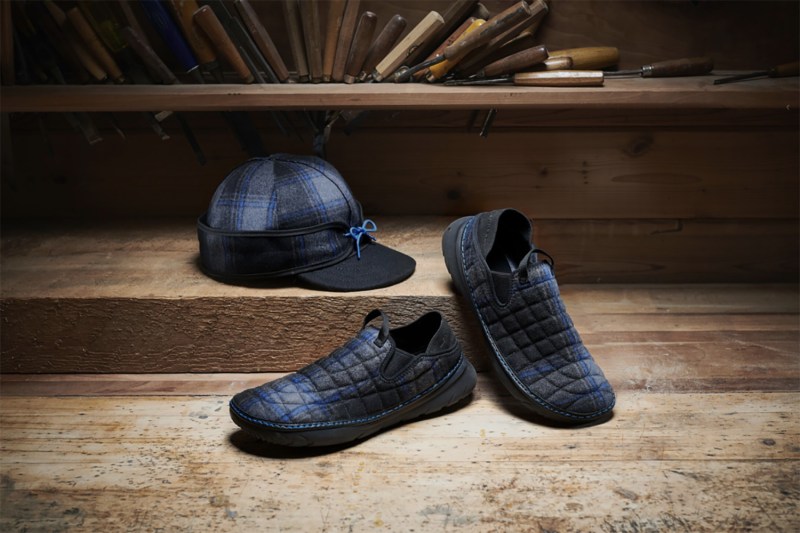There’s a saying about the climate that every Michigander knows all too well:
“Don’t like the weather? Wait five minutes.”
It’s funny because it’s true. Any given day in the Great Lakes State can require as many costume changes as a Diana Ross retrospective. You might walk out the door with a puffy coat, hat, and boots, only to strip down to a T-shirt two hours later, until an unexpected storm front forces you to layer up with a hoodie … all before it’s time for lunch.
With such an unpredictable climate, it’s only natural that Michigan would be home to incredibly versatile outdoor apparel brands. Two of those brands have recently teamed up for a capsule collection that is guaranteed to get you through the highs and lows of fall, winter, spring and the shoulder seasons in between.

Born in the wilds of Michigan’s remote Upper Peninsula, the Stormy Kromer cap is an icon of hardy can-do spirit. The bold Buffalo plaid and the neatly knotted ear flaps instantly call to mind a long day in the deer blind or the ice shanty, as well as the triumph of bringing home the five-point buck or the fifteen-inch lake trout.
Merrell is similarly synonymous with unpretentious, performance-forward outdoor apparel, especially footwear. Its design informed by a Hemingwayesque passion for Michigan’s outdoors, the Merrell shoe marries American cowboy boot design with Italian shoemaking prowess, resulting in footwear that can keep up with that flinty determination Midwesterners are known for.
The new collection features apparel and footwear for both men and women. The keystone of the collection — and the highlight for us –was the men’s hiking boot that features Stormy Kromer’s signature waxed flannel lining paired with Merrell’s Compression-molded EVA midsole and shock-absorbing Air Cushion in the heel.
We spoke with Stormy Kromer president Gina Thorsen about this exciting new collaboration between two legendary outdoor brands born in the northern Midwest.
The Manual: How did this collaboration come about?
Gina Thorsen: Kelly Ballou and I had a mutual connection who introduced us several years ago with the idea of partnering together. It didn’t make sense then, but when Kelly contacted me last year and brought up the possibility of collaboration, I was very excited to make it happen. Stormy Kromer had partnered a few years prior with Wolverine Boots, and that was a great experience. I suspected working with Merrell would be the same. We love partnering with other Michigan brands, especially when we can “bridge” the Upper and Lower Peninsulas. There’s just so much pride in the state behind companies that call it home, and I felt certain our customers would respond extremely well to the project. Merrell is an iconic footwear company, and we were honored that they would be interested in working with us. Ultimately we were able to bring our two iconic brands together, showing off what we each do best but still creating a cohesive collection.
TM: Both companies are named for an iconic individual founder. What about their personalities makes them a perfect match?
GT: George “Stormy” Kromer worked on the Chicago Northwestern Railroad in the Upper Midwest around the turn of the last century. He lost one too many caps to the Midwestern winds, and being a former semi-pro baseball player, he gave his wife Ida an old wool baseball cap and asked her to make a few modifications. They created a cap that stayed on his head and kept his ears warm, and soon his fellow rail workers wanted one of their own.

Similarly, Randy Merrell knew he could create a better hiking boot. So he did. In 1981, Randy’s original leather hiker was rated by Backpacker Magazine as the most comfortable and most functional of all the tested boots sold in North America.
Both of these innovators followed their own compass despite any naysayers, both believed in the companies they built and both built a legacy bigger than themselves.
TM: What shared values does this collection represent?
GT: From a product standpoint, both of our companies put functionality first. Stormy Kromer caps and Merrell boots do what they say they are going to do – whether that’s keeping you warm while ice fishing, or giving the perfect support for your next long-distance hike. That comes with a serious commitment to quality. Our products need to perform, and they need to perform for a long time.
TM: What should more people know about Midwestern brands like these? What makes them distinctive in the saturated outdoor apparel/gear industry?
GT: People should know that these “fresh coast” brands are out there. The Midwest is so often forgotten about in conversations about the east and west coasts, as well as the mountain states, but there is so much great outdoor recreation going on in the Upper Midwest and the Great Lakes region.
In particular, Upper Michigan is starting to be known not just for its iconic natural beauty, but for its blossoming outdoor culture around bike trails, cross country trails, kayaking, paddle boarding and more. The Upper Peninsula, in particular, is as ruggedly beautiful as places like Alaska, and almost as remote.
Because of all these things, there is an authenticity, a grit, an attitude of persistence in the culture and people of the Upper Midwest. The brands that were born here embody this attitude. It’s time for people to know that we have been here for a long time, and we are doing great things.
The new Stormy Kromer x Merrell capsule collection features footwear and apparel for men, women, and children, including a fresh take on the iconic Stormy Kromer cap. You can see the whole collection through the link below.


